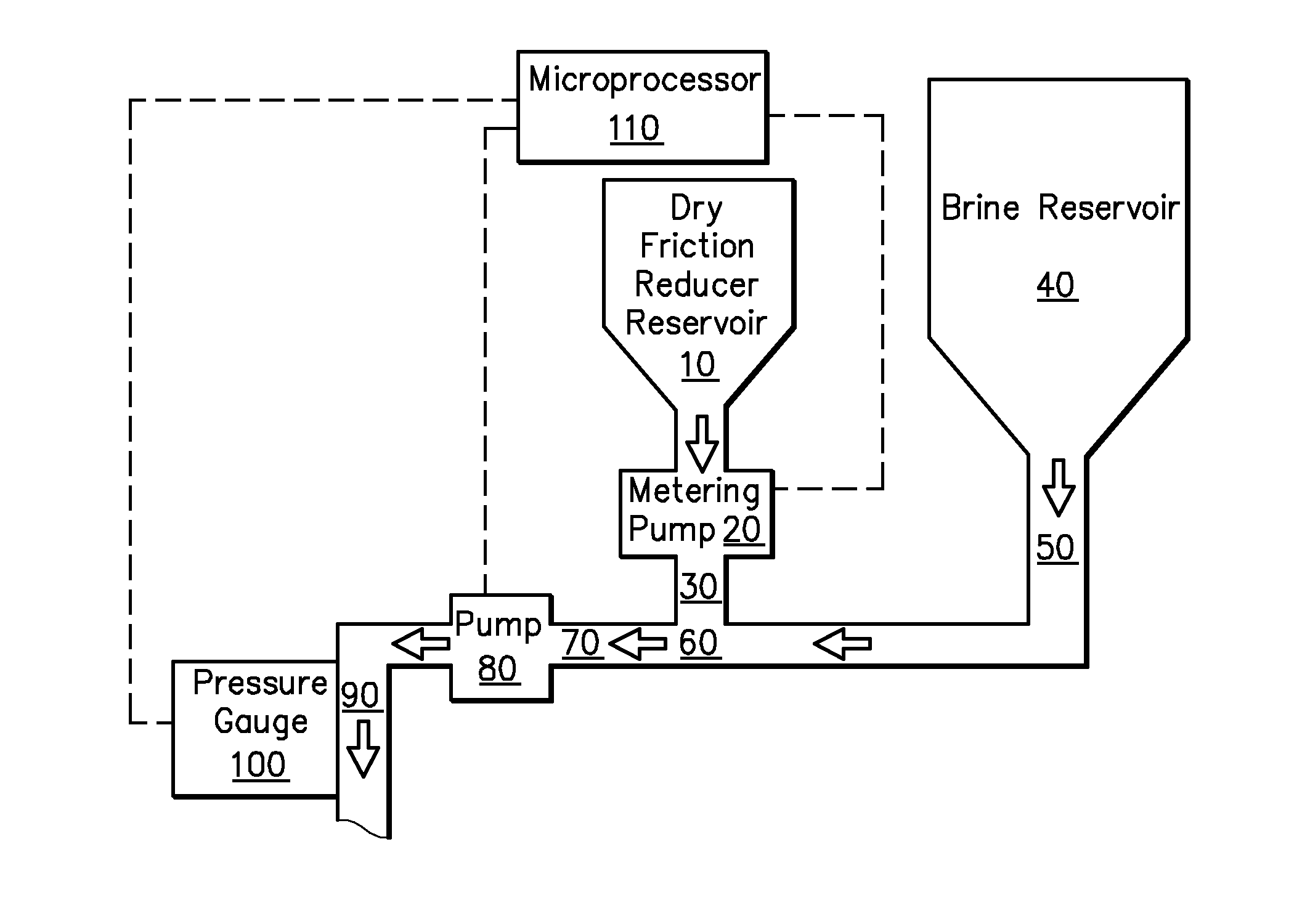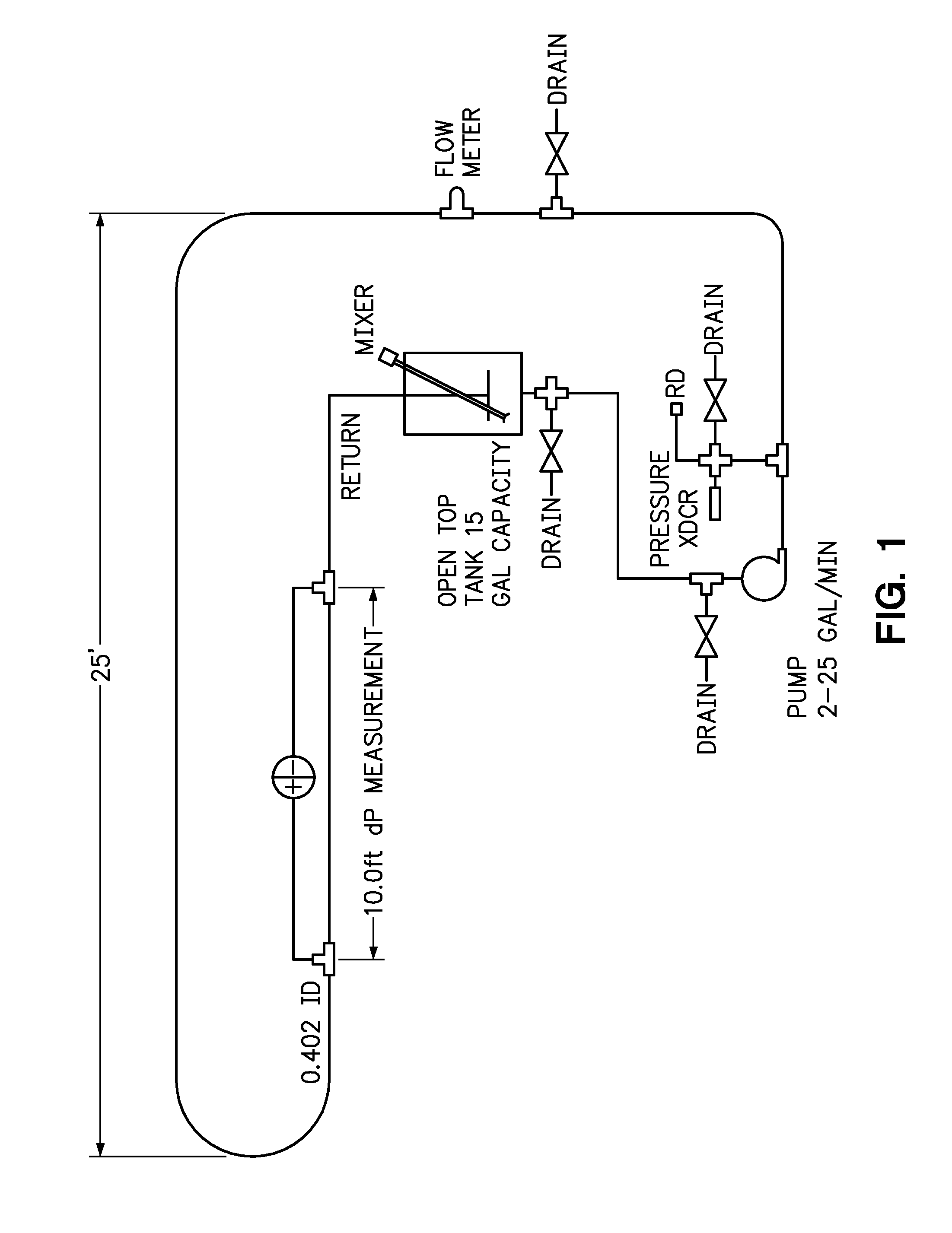Environmentally beneficial recycling of brines in the process of reducing friction resulting from turbulent flow
a technology of brine and process, which is applied in the direction of wellbore/well accessories, sealing/packing, instruments, etc., can solve the problems of increasing the amount of energy required to move fluid at the same speed, affecting the environmental protection of brine, and increasing the pressure of fluid being pumped into the coiled tubing to unacceptable values, so as to reduce the hydrodynamic friction
- Summary
- Abstract
- Description
- Claims
- Application Information
AI Technical Summary
Benefits of technology
Problems solved by technology
Method used
Image
Examples
example 1
Unground Polyacrylamide
[0038]In Example 1, the fluid flowing in the flow-loop was either an API standard brine or a very harsh brine. From the experimental procedure described above, data were collected and are summarized in Table 1:
TABLE 1Relevant data for the unground dry polymerParameterAPI BrineVery Harsh BrineT50 (s) 155 seconds1170 secondsT70 (s)——Tmax (s)1100 seconds1500 secondsMaximum Friction63%51%Reduction Observed
[0039]In Table 1, the parameter “T50(s)” stands for the amount of time in seconds that elapsed after addition of the friction reducer into the fluid until the friction reducer provided a 50% reduction in friction. Similarly, “T70(s)” stands for the amount of time in seconds that elapsed after addition of the friction reducer into the fluid until the friction reducer provided a 70% reduction in friction, and “Tmax(s)” stands for the amount of time in seconds that elapsed after addition of the friction reducer into the fluid until the friction reducer provided its ...
example 2
[0041]In Example 2, the fluid flowing in the flow-loop was an API standard brine or a very harsh brine. From the experimental procedure described above, the collected data have been summarized and tabulated in Table 2:
TABLE 2Relevant data for the Kemira A-4370 emulsion polymerParameterAPI BrineVery Harsh BrineT50 (s)11 seconds101 secondsT70 (s)30 seconds—Tmax (s)82 seconds160 secondsMaximum Friction75%53%Reduction Observed
[0042]The polymer in this Example was an emulsion polymer A-4370 available commercially from Kemira Chemicals, Inc., 387 Technology Circle, Suite 300, Atlanta, Ga. 30313. The polymer was applied at a rate of 1 gallon per thousand gallons of brine. The dosage rate of 1 gallon per thousand gallons of brine for the emulsion polymer in this Example is equivalent to a rate of 2.67 pounds per thousand gallons of brine. The data in Table 2 show that the Kemira A-4370 emulsion polymer was sometimes relatively fast in hydrating and yielding its hydrodynamic ...
example 3
Finely Ground Polyacrylamide
[0043]In Example 3, the fluid flowing in the flow-loop was either an API standard brine or a very harsh brine. From the experimental procedure described above, the collected data have been summarized and tabulated in Table 3:
TABLE 3Relevant data for the finely ground dry polymer inAPI and very harsh brine.Dry PolymerDry PolymerDry Polymer10-10010-100 Microns10-53 MicronsMicrons inin Veryin VeryParameterAPI BrineHarsh BrineHarsh BrineT50 (s) 8 seconds11 seconds 7 secondsT70 (s)15 seconds36 seconds15 secondsTmax (s)30 seconds51 seconds30 secondsMaximum Friction75%72%75%Reduction Observed
[0044]The polymer in this Example was a powdered solid, water-soluble, non-dispersion polyacrylamide polymer, ground into the 10 to 100 microns range in two cases and into the 10 to 53 microns range in one case. The polymer was applied to the fluid at a rate of 2.67 pounds per thousand gallons of brine. The data in Table 3 shows that the performance of polyacrylamide as a fr...
PUM
| Property | Measurement | Unit |
|---|---|---|
| electrical conductivity | aaaaa | aaaaa |
| average particle diameter | aaaaa | aaaaa |
| average particle diameter | aaaaa | aaaaa |
Abstract
Description
Claims
Application Information
 Login to View More
Login to View More - R&D
- Intellectual Property
- Life Sciences
- Materials
- Tech Scout
- Unparalleled Data Quality
- Higher Quality Content
- 60% Fewer Hallucinations
Browse by: Latest US Patents, China's latest patents, Technical Efficacy Thesaurus, Application Domain, Technology Topic, Popular Technical Reports.
© 2025 PatSnap. All rights reserved.Legal|Privacy policy|Modern Slavery Act Transparency Statement|Sitemap|About US| Contact US: help@patsnap.com



